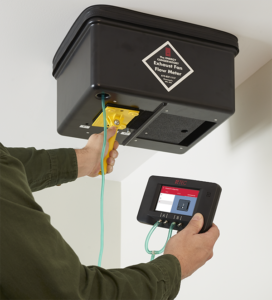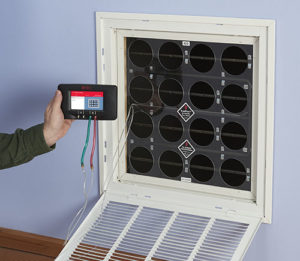Exhaust Fan Flow Meter

As the ASHRAE Standard 62.2 becomes more widely adopted, measuring accurate airflow from exhaust fans has become more important. Also, accurately measuring exhaust fan airflow will confirm that the fan is preforming to its rated flow and can aid in diagnosing depressurization problems in a home.
The Energy Conservatory’s (TEC) Exhaust Fan Flow Meter is designed to make quick and accurate measurements of air flow through residential exhaust fans. The effective air flow measurement range for the Exhaust Fan Flow Meter is 10 to 124 cubic feet per minute (CFM). The device should be used along with a pressure gauge providing 0.1 Pascals (0.0004 in. w.c.) of resolution in the range of 1 to 8 Pascals. When used with TEC’s DG-700 digital pressure gauges, the accuracy of the exhaust fan flow measurement is +/- 10%.
During the measurement procedure, the Exhaust Fan Flow Meter is placed directly over the exhaust fan grille and is pushed up against the wall or ceiling so that the flexible gasket on the end of the Metering Box creates an air tight seal around the grille. The pressure reading taken from the Exhaust Fan Flow Meter is easily converted to air flow in CFM using a flow table attached to the side of the Metering Box. The DG-700 or DG-3 digital pressure gauge can also be set up to display air flow readings directly in CFM. The Exhaust Fan Flow Meter has 3 calibrated openings to provide an accurate measurement over the full range of the device. A short handle is provided which can be attached to the Metering Box using Velcro strips. The handle is designed to allow a standard painter’s pole or broom handle (not included) to be screwed into the open end of the handle to provide access to exhaust fan grilles mounted high on walls, or on ceilings.
TrueFlow® Air Handler Flow Meter

The air flow rate through residential air handlers is an important variable in estimating and optimizing the performance of heat pumps, air conditioners and furnaces. Numerous field studies of installed heating and cooling systems around the United States have found that insufficient air flow across the indoor coil is an extremely common problem. Low air flow can lead to decreased heating and cooling system capacity, increased energy use and comfort problems.
The most widely used methods for estimating the air handler flow rate, (the temperature rise method, static pressure and fan curve method, and the Duct Blaster® isolated return method) have been found to be either problematic or time-consuming to perform. The Energy Conservatory’s TrueFlow® Air Handler Flow Meter is designed to provide a simple and accurate measurement of air flow through residential air handlers rated from 1 to 5 tons. The TrueFlow Meter temporarily replaces the filter in a typical air handler system during the airflow measurement procedure. If the filter location is directly adjacent to the air handler, the TrueFlow Meter will measure the total air handler flow. If the filter is located remotely at a single central return, the TrueFlow Meter will measure the airflow through the central return.
Extensive field testing of the TrueFlow Meter has shown that it:
- Is easy and fast to use in the field. The TrueFlow Meter provides direct CFM readings in approximately 2 to 4 minutes without extensive calculations or setup. The TrueFlow Meter requires about the same time as the single-point temperature rise method, when including the time required in the temperature method to measure the output capacity.
- Can be used in a wide range of return plenums and air handler fan configurations. Adjustable sizing of the TrueFlow Meter allows it to fit most standard filter slots. Custom adjustments for unusual filter sizes can be easily made by the operator.
- Has a flow accuracy of +/ 7% for most applications when used with a pressure gauge having an accuracy of 1% of reading. The TrueFlow Meter is approximately 4 times more accurate than the single-point temperature rise method, and of comparable accuracy to the Duct Blaster isolated return method.
- Is applicable to many systems for which the temperature rise method cannot be used due to inadequate or absent supply plenum temperature measurement points.
- Can be used with any manometer which has a resolution of 1 Pascal or 0.005 In H2O.
